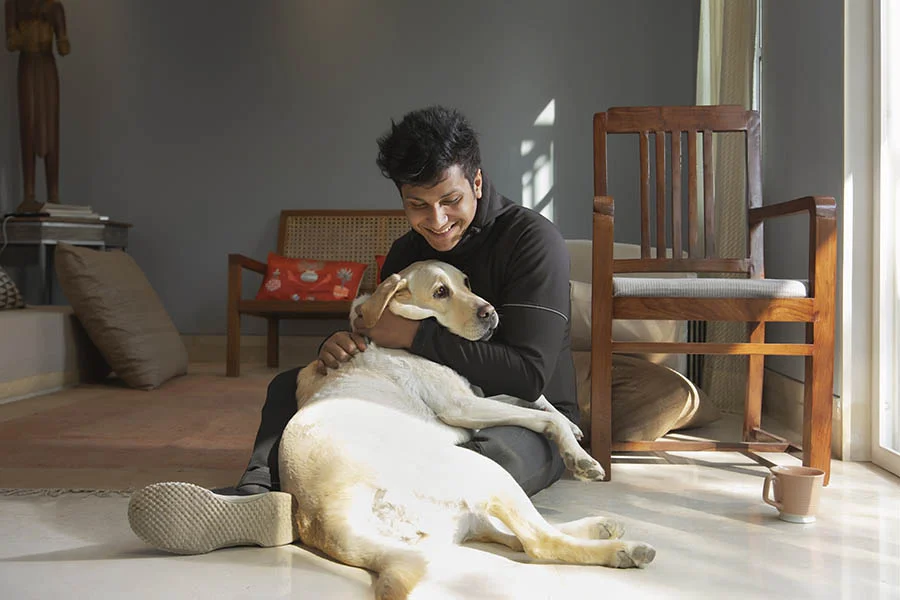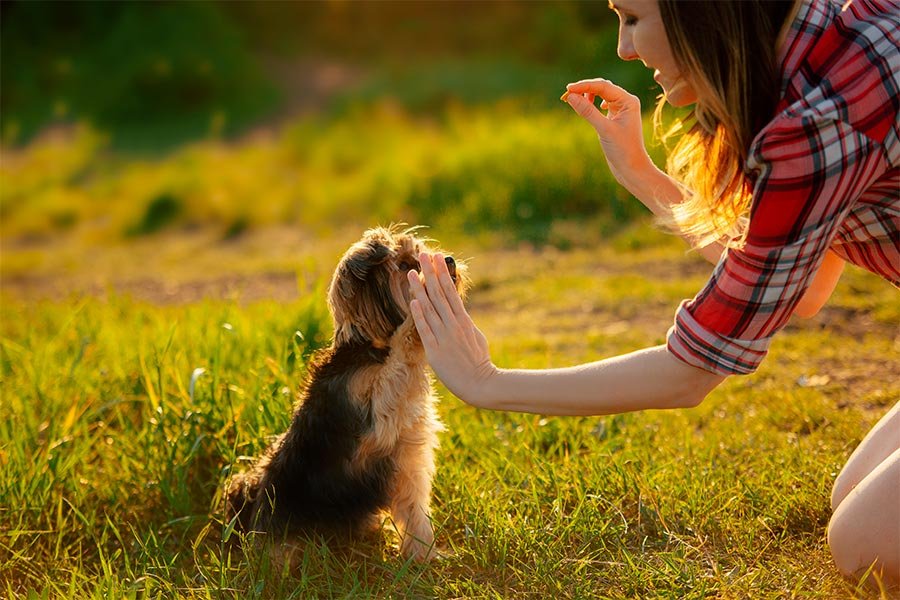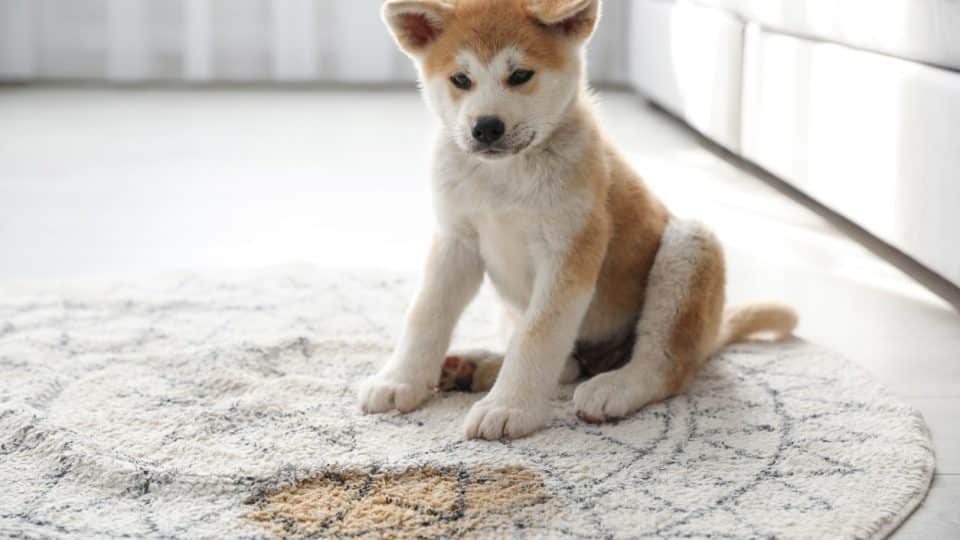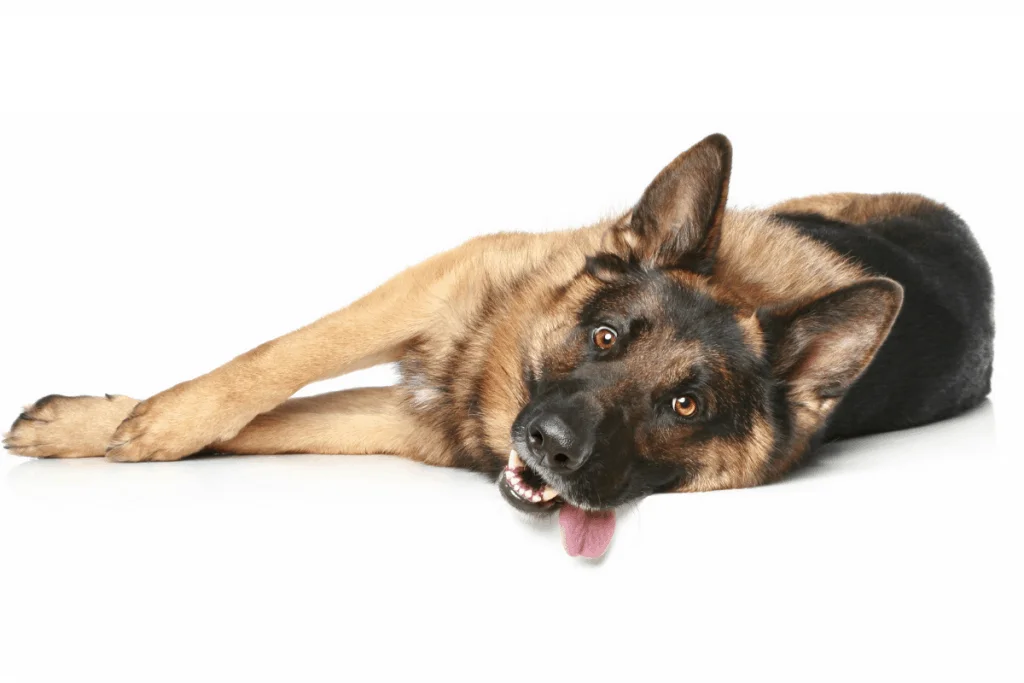Submissive urination is a common problem that many dog owners face, especially with young or timid dogs. It is a behavior that occurs when a dog feels threatened, nervous, or submissive, and urinates involuntarily as a way of showing deference or appeasement.
Table of Contents
Submissive urination can be frustrating and embarrassing for both the dog and the owner, but it is not a sign of disobedience or lack of training. In fact, scolding or punishing the dog for this behavior can make it worse, as it can increase the dog’s fear and anxiety.
In this guide, we will explain the causes, triggers, and identification of submissive urination in dogs, and provide you with effective training techniques and holistic methods to address this issue. We will also discuss the difference between submissive and excitement urination, which are often confused, and how to deal with both of them.
What is Submissive Urination in Dogs?
Submissive urination is a natural and instinctive behavior that dogs use to communicate their social status and avoid conflict. It is most commonly seen in puppies, who are still learning their place in the pack and how to interact with other dogs and humans.
Puppies may urinate when they greet their mother, siblings, or other adult dogs, as a way of showing respect and submission. This behavior usually fades away as the puppy grows up and gains confidence and social skills.
Also Read: 9 Strong Reasons for Dog Dry Heaving but Acting Normal: Causes and Treatment.
However, some dogs may continue to exhibit submissive urination into adulthood, especially if they are shy, anxious, or have a history of abuse or trauma.
These dogs may urinate when they encounter situations that make them feel insecure, such as meeting new people or animals, being approached or touched by someone, hearing loud noises, or being scolded or punished.
Submissive urination is not a deliberate act of defiance or disrespect, but rather a reflexive response to stress or fear.
How to Tell the Difference Between Submissive and Excitement Urination
Submissive urination is often confused with another type of involuntary urination in dogs: excitement urination. Excitement urination is also a common problem, especially in puppies and young dogs, who have not yet developed full bladder control.
Excitement urination occurs when a dog is overstimulated or aroused by something positive, such as greeting their owner, playing, or receiving attention. Unlike submissive urination, excitement urination is not related to fear or submission, but rather to joy and enthusiasm.
The easiest way to tell the difference between submissive and excitement urination is to look at the dog’s body language and the context of the situation. A dog who is urinating submissively will usually display signs of fear or submission, such as crouching, lowering their head, tucking their tail, rolling over, or avoiding eye contact.
A dog who is urinating out of excitement will usually display signs of happiness or eagerness, such as wagging their tail, jumping, licking, or barking. A dog who is urinating submissively will usually do so when they feel threatened or intimidated, such as when someone approaches them, stands over them, or uses a loud voice.
A dog who is urinating out of excitement will usually do so when they feel happy or excited, such as when someone greets them, praises them, or plays with them.
It is important to understand the difference between submissive and excitement urination, as they require different approaches and training methods. In this guide, we will focus on how to deal with submissive urination, but we will also briefly mention how to address excitement urination later on.
What Causes, Triggers, and Identifies Submissive Urination in Dogs?
Submissive urination in dogs is caused by a combination of psychological and physiological factors. The main psychological factor is the dog’s temperament, which is influenced by their genetics, early socialization, and life experiences.
Some dogs are naturally more timid, sensitive, or submissive than others, and are more prone to urinate when they feel stressed or scared. These dogs may have inherited this trait from their parents, or may have developed it due to lack of proper socialization or exposure to different people, animals, and environments during their critical period of development (between 3 and 14 weeks of age).
These dogs may also have experienced trauma, abuse, or neglect, which can damage their trust and confidence, and make them more fearful and anxious.
The main physiological factor is the dog’s bladder control, which is influenced by their age, health, and diet. Puppies and young dogs have not yet developed full bladder control, and may not be able to hold their urine when they are excited or nervous.
Older dogs may also have reduced bladder control due to aging, illness, or injury. Dogs who drink a lot of water, eat salty or spicy foods, or have urinary tract infections or other medical conditions may also have more frequent or urgent urination needs.
The triggers of submissive urination in dogs vary depending on the individual dog and the situation, but some common ones are:
- Meeting new people or animals, especially if they are larger, louder, or more dominant than the dog
- Being approached, touched, or picked up by someone, especially if they are unfamiliar, sudden, or rough
- Being scolded, punished, or yelled at by someone, especially if they are harsh, angry, or violent
- Hearing loud noises, such as thunder, fireworks, sirens, or alarms
- Being in a new or unfamiliar environment, such as a vet clinic, a groomer, or a boarding facility
- Being left alone for a long time, or experiencing separation anxiety
- Having a change in their routine, schedule, or household, such as moving, traveling, or having a new baby or pet
The identification of submissive urination in dogs is based on observing the dog’s behavior and the context of the situation. As mentioned earlier, a dog who is urinating submissively will usually display signs of fear or submission, such as crouching, lowering their head, tucking their tail, rolling over, or avoiding eye contact.
The dog will usually urinate a small amount, often without lifting their leg or squatting, and may not even realize they are doing it. The dog will usually urinate when they feel threatened or intimidated, such as when someone approaches them, stands over them, or uses a loud voice.
How to Train Your Dog to Stop Submissive Urination

The good news is that submissive urination in dogs can be managed and reduced with proper training and care. The key is to use positive reinforcement and avoid any negative or punitive methods that can worsen the problem. Here are some effective training techniques to address submissive urination in dogs:
Build your dog’s confidence and trust
A confident and secure dog is less likely to urinate submissively, so it is important to help your dog develop a positive self-image and a strong bond with you. You can do this by providing your dog with a safe and comfortable environment, a consistent and predictable routine, and plenty of love and attention.
You can also enroll your dog in obedience classes, agility courses, or other activities that can boost their skills and self-esteem. You can also teach your dog some basic commands, such as sit, stay, and come, and reward them with praise, treats, or toys when they obey.
This will help your dog learn to listen to you and follow your cues, and also reinforce your role as a leader and a protector.
Avoid triggering situations or minimize their impact
If you know what triggers your dog’s submissive urination, you can try to avoid them or reduce their intensity. For example, if your dog urinates when meeting new people or animals, you can introduce them gradually and calmly, and let your dog approach them at their own pace.
You can also ask the person or animal to ignore your dog at first, and avoid direct eye contact, loud noises, or sudden movements. You can also give your dog a treat or a toy when they meet someone new, to create a positive association. If your dog urinates when being approached or touched by someone, you can ask the person to kneel down or sit on the floor, and let your dog come to them.
You can also ask the person to pet your dog gently under the chin or on the chest, rather than on the head or the back, which can be seen as a sign of dominance. If your dog urinates when being scolded or punished by someone, you can avoid using harsh or angry tones, and instead use a firm but calm voice.
You can also avoid physical punishment, such as hitting, kicking, or shaking your dog, which can be traumatic and abusive. Instead, you can use a time-out method, where you ignore your dog or put them in a separate room for a few minutes, to let them calm down and learn from their mistake.
Reward your dog for good behavior

One of the most effective ways to train your dog to stop submissive urination is to reinforce their good behavior and ignore their bad behavior. You can do this by rewarding your dog with praise, treats, or toys when they do not urinate submissively, and ignoring them or cleaning up the mess without making a fuss when they do.
For example, if your dog does not urinate when greeting you, you can give them a treat or a toy, and tell them they are a good dog. If your dog does urinate when greeting you, you can calmly clean up the mess, and avoid scolding or punishing your dog.
This will help your dog learn that urinating submissively does not get them any attention or affection, and that not urinating submissively does. Over time, this will reduce the frequency and severity of this kind of urination.
How to Address Excitement Urination in Conjunction

As we discussed earlier, excitement urination is another type of involuntary urination in dogs, that is often confused with submissive urination. Excitement urination occurs when a dog is overstimulated or aroused by something positive, such as greeting their owner, playing, or receiving attention. Unlike submissive urination, excitement urination is not related to fear or submission, but rather to joy and enthusiasm.
Excitement urination is also a common problem, especially in puppies and young dogs, who have not yet developed full bladder control. Excitement urination can be annoying and messy, but it is usually not a serious issue, and most dogs outgrow it as they mature and learn to control their bladder.
However, some dogs may continue to exhibit excitement urination into adulthood, especially if they are very energetic, playful, or affectionate. In this case, you may need to use some training methods to address this issue, in conjunction with the methods for dealing with submissive urination.
Here are some training methods specifically for dealing with excitement urination in dogs:
Reduce the level of excitement or stimulation
One of the simplest ways to prevent excitement urination in dogs is to reduce the level of excitement or stimulation that triggers it. For example, if your dog urinates when greeting you, you can try to greet them in a calm and low-key manner, and avoid making a big fuss over them.
You can also ignore your dog for a few minutes when you come home, and wait until they calm down before giving them attention. If your dog urinates when playing, you can try to play with them in a gentle and relaxed way, and avoid rough or vigorous games that can get them too excited.
You can also limit the duration and frequency of play sessions, and give your dog a break when they show signs of overexcitement, such as panting, barking, or jumping.
Teach your dog to sit and stay
Another effective way to prevent excitement urination in dogs is to teach them to sit and stay on command. This will help your dog learn to control their impulses and emotions, and also give them a way to calm themselves down when they are excited.
You can do this by using positive reinforcement and treats, and gradually increasing the difficulty and duration of the exercise. For example, you can start by asking your dog to sit and stay for a few seconds, and reward them with a treat when they do. Then, you can gradually increase the time and distance, and also introduce distractions, such as other people, animals, or noises.
You can also practice this exercise in different situations, such as when someone comes to the door, when you are about to feed your dog, or when you are about to go for a walk. This will help your dog learn to sit and stay in any situation, and also reduce their excitement urination.
Reward your dog for good behavior
As with submissive urination, one of the most effective ways to train your dog to stop excitement urination is to reinforce their good behavior and ignore their bad behavior. You can do this by rewarding your dog with praise, treats, or toys when they do not urinate out of excitement, and ignoring them or cleaning up the mess without making a fuss when they do.
For example, if your dog does not urinate when greeting you, you can give them a treat or a toy, and tell them they are a good dog. If your dog does urinate when greeting you, you can calmly clean up the mess, and avoid scolding or punishing your dog.
This will help your dog learn that urinating out of excitement does not get them any attention or affection, and that not urinating out of excitement does. Over time, this will reduce the frequency and severity of excitement urination in dogs.
Conclusion
Submissive and excitement urination are common problems that many dog owners face, especially with young or timid dogs. They are behaviors that occur when a dog feels threatened, nervous, or submissive, or when a dog feels happy or excited, and urinates involuntarily as a way of showing deference or appeasement, or as a result of overstimulation or arousal.
Submissive and excitement urination can be frustrating and embarrassing for both the dog and the owner, but they are not signs of disobedience or lack of training. In fact, scolding or punishing the dog for these behaviors can make them worse, as they can increase the dog’s fear and anxiety, or excitement and arousal.
The best way to deal with submissive and excitement urination in dogs is to use positive reinforcement and avoid any negative or punitive methods that can worsen the problem.
You can also manage these issues holistically, by addressing the underlying causes and triggers of these behaviors. You can also seek veterinary care for any medical conditions that may be contributing to these behaviors.
With patience, consistency, and proper training, you can successfully manage submissive and excitement urination in dogs, and enjoy a happy and healthy relationship with your furry friend.

